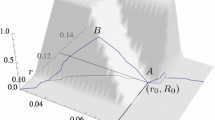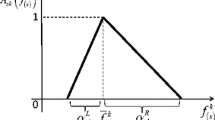Abstract
This paper develops a robust method to describe fuzzy returns by employing parametric possibility distributions. The parametric possibility distributions are obtained by equivalent value (EV) reduction methods. For common type-2 triangular and trapezoidal fuzzy variables, their reduced fuzzy variables are studied in the current development. The parametric possibility distributions of reduced fuzzy variables are first derived, then the second moment formulas for the reduced fuzzy variables are established. Taking the second moment as a new risk measure, the reward-risk and risk-reward models are developed to optimize fuzzy portfolio selection problems. The mathematical properties of the proposed optimization models are analyzed, including the analytical representations for the second moments of linear combinations of reduced fuzzy variables as well as the convexity of second moments with respect to decision vectors. On the basis of the analytical representations for the second moments, the reward-risk and risk-reward models can be turned into their equivalent parametric quadratic convex programming problems, which can be solved by conventional solution methods or general-purpose software. Finally, some numerical experiments are performed to demonstrate the new modeling ideas and the efficiency of solution method.
Similar content being viewed by others
Explore related subjects
Discover the latest articles, news and stories from top researchers in related subjects.References
Arenas-Parra M., Bilbao-Terol A., Rodríguez-Uría M. V. (2001) A fuzzy goal programming approach to portfolio selection. European Journal of Operational Research 133: 287–297
Carter M., Van Brunt B. (2000) The Lebesgue-Stieltjes integral. Springer, Berlin
Chen G., Liao X., Wang S. (2009) A cutting plane algorithm for MV portfolio selection model. Applied Mathematics and Computation 215: 1456–1462
Chen Y., Zhang L. (2011) Some new results about arithmetic of type-2 fuzzy variables. Journal of Uncertain Systems 5: 227–240
Duan L., Stahlecker P. (2011) A portfolio selection model using fuzzy returns. Fuzzy Optimization and Decision Making 10: 167–191
Dubois D., Prade H. (1979) Operations in a fuzzy-valued logic. Information and Control 43: 224–240
Huang X. (2009) A review of credibilistic portfolio selection. Fuzzy Optimization and Decision Making 8: 263–281
Huang X. (2010) Portfolio analysis: From probabilistic to credibilistic and uncertain approaches. Springer, Berlin
Jorion P. H. (1996) Value at risk: A new benchmark for measuring derivatives risk. Irwin Professional Publishers, Chicago
Karnik N. N., Mendel J. M. (2001) Centroid of a type-2 fuzzy set. Information Sciences 132: 195–220
Kelley J. E. (1960) The cutting-plane method for solving convex programs. Journal of the Society for Industrial and Applied Mathematics 8: 703–712
Konno H., Yamakazi H. (1991) Mean-absolute deviation portfolio optimization model and its applications to Tokio stock market. Management Science 37: 519–531
Liu B. (2004) Uncertainty theory. Springer, Berlin
Liu B., Liu Y. (2002) Expected value of fuzzy variable and fuzzy expected value models. IEEE Transactions on Fuzzy Systems 10: 445–450
Liu Z., Liu Y. (2010) Type-2 fuzzy variables and their arithmetic. Soft Computing 14: 729–747
Markowitz H. M. (1952) Portfolio selection. Journal of Finance 7: 77–91
Markowitz H. M. (1959) Portfolio selection: Efficient diversification of investments. Wiley, New York
Mendel J. M., John R. I. (2002) Type-2 fuzzy sets made simple. IEEE Transactions on Fuzzy Systems 10: 117–127
Mendel J. M. (2007) Advances in type-2 fuzzy sets and systems. Information Sciences 177: 84–110
Mitchell H. (2005) Pattern recognition using type-II fuzzy sets. Information Sciences 170: 409–418
Mizumoto M., Tanaka K. (1976) Some properties of fuzzy sets of type-2. Information and Control 31: 312–340
Qin R., Liu Y., Liu Z. (2011a) Methods of critical value reduction for type-2 fuzzy variables and their applications. Journal of Computational and Applied Mathematics 235: 1454–1481
Qin R., Liu Y., Liu Z. (2011b) Modeling fuzzy data envelopment analysis by parametric programming method. Expert Systems with Applications 38: 8648–8663
Rockafellar T. R., Uryaser S. P. (2000) Optimization of conditional value-at-risk. Journal of Risk 2: 21–41
Wu X., Liu Y. (2011) Spread of fuzzy variable and expectation-spread model for fuzzy portfolio optimization problem. Journal of Applied Mathematics and Computing 36: 373–400
Zadeh L. A. (1965) Fuzzy sets. Information and Control 8: 338–353
Zadeh L. A. (1975) Concept of a linguistic variable and its application to approximate reasoning I. Information Sciences 8: 199–249
Zadeh L. A. (1978) Fuzzy sets as a basis for a theory of possibility. Fuzzy Sets and Systems 1: 3–28
Author information
Authors and Affiliations
Corresponding author
Rights and permissions
About this article
Cite this article
Wu, XL., Liu, YK. Optimizing fuzzy portfolio selection problems by parametric quadratic programming. Fuzzy Optim Decis Making 11, 411–449 (2012). https://doi.org/10.1007/s10700-012-9126-9
Published:
Issue Date:
DOI: https://doi.org/10.1007/s10700-012-9126-9




